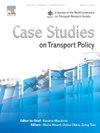COVID-19 and its influence on the propensity to work from home between March 2020 and June 2021
IF 2.4
Q3 TRANSPORTATION
引用次数: 0
Abstract
The COVID-19 pandemic has had a significant impact on the world of work. With growing support and preference revelation from both employees and employers, we might anticipate a settling in of working from home around one to two days a week, varying by occupation depending on the ability to work remotely. Although there are a growing number of studies that have analysed data collected at a point in time or over time during the pandemic, there is now sufficient time and data to treat the waves of collected data as a repeated cross section that is jointly modelled to assess systematically, the changing roles of various influences on the proportion of working days that are worked from home. This paper estimates random effects regression models for the Greater Sydney Metropolitan Area and South-East Queensland over four waves of data collected in 2020 and 2021, where this last one represents a period with almost full vaccinations and minimum restrictions (i.e., ‘new normal’). By jointly estimating four waves of data within a single modelling framework, we are able to track the changing roles of the influences found to be statistically significant across the waves. The elasticity outputs reveal how these influences impact on the propensity to WFH, giving clues on whether we were starting to see a stabilisation of WFH activity mid-way in the pandemic period that can be reflective of a ‘new normal’. Results are very supportive of employees’ preferences, suggesting that those that feel the same or more productive when working from home relative to going to the office, are more likely to working from home relative to those that feel less productive.
COVID-19 及其对 2020 年 3 月至 2021 年 6 月期间在家工作倾向的影响
COVID-19 大流行对工作领域产生了重大影响。随着雇员和雇主对在家工作的支持和偏好不断增加,我们可以预见,在家工作将逐渐成为一种趋势,每周大约有一到两天的时间在家工作,不同职业的情况会有所不同,这取决于远程工作的能力。尽管有越来越多的研究分析了在大流行期间某一时点或一段时间内收集到的数据,但现在有足够的时间和数据将收集到的数据作为一个重复的横截面来处理,并对其进行联合建模,以系统地评估各种影响因素对在家工作的工作日比例所起的不断变化的作用。本文估计了大悉尼都市区和昆士兰东南部在 2020 年和 2021 年收集的四波数据的随机效应回归模型,其中最后一波数据代表了几乎全面接种疫苗和最低限制(即 "新常态")的时期。通过在单一建模框架内对四波数据进行联合估算,我们能够跟踪在统计上具有显著意义的影响因素在各波数据中的作用变化。弹性输出结果揭示了这些影响因素对全职工作倾向的影响,为我们提供了线索,说明我们是否开始看到全职工作活动在大流行病中期趋于稳定,从而反映出一种 "新常态"。研究结果非常支持员工的偏好,表明那些在家工作时感觉与去办公室工作效率相同或更高的员工,相对于那些感觉工作效率较低的员工,更倾向于在家工作。
本文章由计算机程序翻译,如有差异,请以英文原文为准。
求助全文
约1分钟内获得全文
求助全文

 求助内容:
求助内容: 应助结果提醒方式:
应助结果提醒方式:


